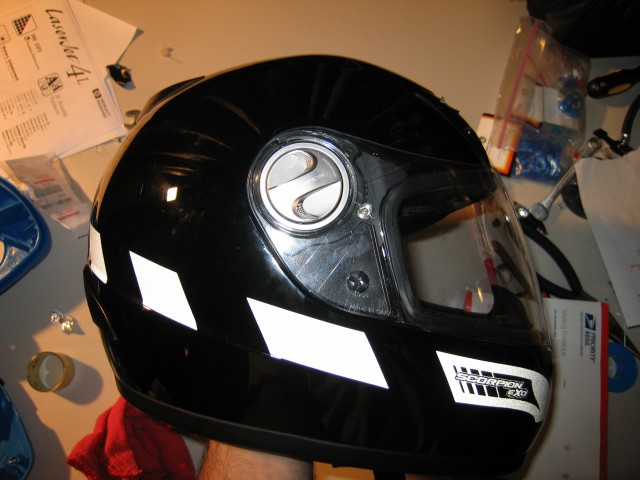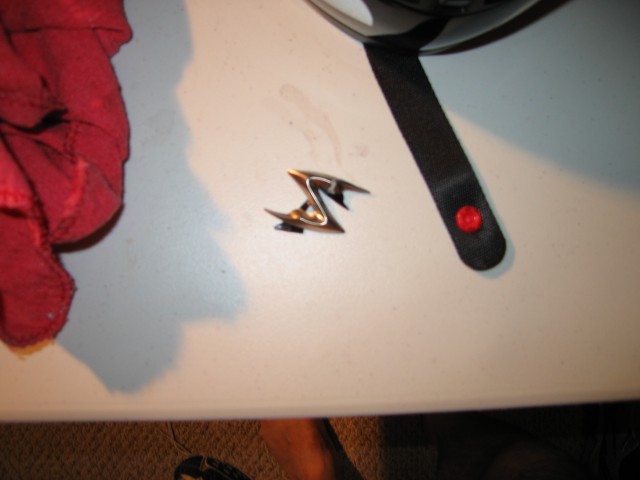Last Fall I purchased a Scorpion EXO 400 helmet. It wasn’t the helmet I was hoping to get but the local motorcycle gear shops (all two of them) couldn’t get anything in my size except for the EXO 400. The shop owner at the store I purchased it from swore up and down to me that the helmet would be quiet and comfortable. She was right about it being comfortable. Finding an XXXL helmet really has improved my comfort level over my old XXL melon protector. However, the thing sounds like I have my head inside a jet engine when I ride my PC800. Had the shop allowed me to return it (strict no-return policy once the helmet leaves the door), I would have taken it back. But since it is was now mine, I decided to try to make some modifications to improve the noise situation.
Before you read any farther I would strongly recommend you don’t try this at home. In fact, don’t read any farther. It is dangerous to your health. I’m not responsible or liable for anything you do or do not do based on what you read here. You’ve been warned!
This is the unmodified helmet. I put the reflective strips on (waste of money to buy the Scorpion-branded reflective strips. Buy reflective tape and do it yourself for half the price) but otherwise the helmet is unmodified.
First I tried filling in the lock system that is used to change in and out face shields. It helped just a little but not very much.
Next I decided the strange lightning bolt / “S” on the front of the helmet had to go. Not only does it look silly but it could be a source of noise.
And away it goes! Now the helmet looks much better.
The decal was held on by a few piece of double-sided tape. I used a pair of needle nose pliers to get it off the helmet.
Next I tried using some black silicone caulking to smooth out the rough spots on the back of the helmet.
Then I got serious. That is a whole bunch of clear silicone caulking all over the side of the helmet. It actually has lowered the noise level noticeably. My two theories on why it is quieter are 1) that the air flow is more laminar and 2) the extra material helps to deaden the sound reaching my ears.
The funny thing stuck to the face shield is a SuperVisor. It costs about $20 shipped and is entirely worth every penny. I used to have issues with getting sun in my eyes on evening or morning rides. Now I don’t have that problem. Also it has helped to reduce the noise I get in the helmet. I highly recommend it.
The other side of the helmet. I’ve gotten many comments about my “ratted out” helmet and questions about the “wicked accident” I must have been in to require this “patch job.” I smile and inform everyone that it is simply for soundproofing.
The whole helmet must look ridiculous going down the highway. I wonder what it appears to look like when headlights wash over the side of my helmet at night.
I also put caulking between the visor and the helmet. I was having some trouble with leaks in the rain down the front of the visor (still do but they’re less now). Also I suspected that there was an eddy current from the wind in that little open space.
Top view of the helmet. You can also see the four mounting tabs for the Super Visor on the face shield. It was nerve-wracking when I put those tabs on (once you start, you either go all the way or you’ve ruined a face shield) but it was so very worth it.
As an epilogue to this soundproofing expedition I will say that the noise level hasn’t been reduced all that much by these modifications. Yes, it is better, but the helmet is still too loud. The biggest improvement I’ve made to date was switching from a Clearview +3 to a Clearview +5 windshield. By no means is my setup noise-free but with those two extra inches of windshield between me and the air column, it has made an improvement. In the fall I think it will be time to buy another new helmet. This time I am planning to make a day trip out of riding to a bigger city where I might find a shop with XXXL helmets in stock that will let me try them out on the road before I buy.
As always, YMMV.














I was googling around to find out about sound proofing helmet and stumbled upon your blog.
all I can say was HA! HA! HA! HA! HA! HA! because I had been thinking about those chalk/silicon glue thing.
Well, still thinking about it. Maybe I’ll stick to filling gaps with felt pads. Seems to work (cause I can now hear my mp3) but still needs a lot of work.
MAybe I should just go buy a really-really big gigantic visor for my scooter (which may double up as a sail if the wind direction is right)
When you don’t have much money for a fancy helmet, you’ll go to great lengths to try and make-do! I ended up upgrading my windshield which has helped quite a bit. Someday I’ll get a better helmet. Someday…
Just like you, I went for the cheapest functional flip up money can buy
And just like you, I DIY my so called sound proofing by making the helmet more aerodynamic.
Gaps, screw holes are sealed and filled with self adhesive felt pads and/or insulating tape (cause they stretch and deformed to whatever you stick them to)
And from your blog here, I can deduce that streamlining the gap at the connecting end of the visor connection reduces a lot of wind noise. I will be trying it later tonite..and will let u know in a few days
cheers!!
Hi Douglas,
https://www.facebook.com/media/set/?set=a.10150090445635238&l=ad19eb08fd
works nice. Previously, I can’t hear a thing other than wind noise. Now I can hear the wheez of my scooter gearbox, even at speed above 100kmph.
The link didn’t work. Can you send the direct image URL?
I’ve been thinking about putting some padding in the speaker holes in mine to dampen the noise more. At 100kmph mine can still be a bit noisy.
The biggest noise reduction I received was when I installed a Laminar Lip to my windshield.
Hi Bob,
When I upgraded from a +3 to a +5 Clearview windshield, it greatly reduced the noise. One of these days I should do as you suggest and get a Laminar Lip. It sure is cheaper than getting a Clearview +6 🙂
Cheers,
Douglas
Hey Douglas, nice work ( for your ears…).I always search the lowest noise level while riding,seems to be less tired. The decibels are very high inside a helmet. See the link:
All the gaps on the helmet and air flow entries are significant with the noise, but I find that the neck area is important too. Try to isolate as maximum you can and see the difference.
http://www.helmetmuffler.com/index.shtml
Cheers
Hi Francisco,
Noise is a big problem with helmets. I tried different configurations with my helmet to block air flow like the second link you had but with my motorcycle, most of the noise comes from buffeting of the top and sides of the helmet. The windshield on the bike protects the lower part of my helmet from wind.
Cheers!
Douglas